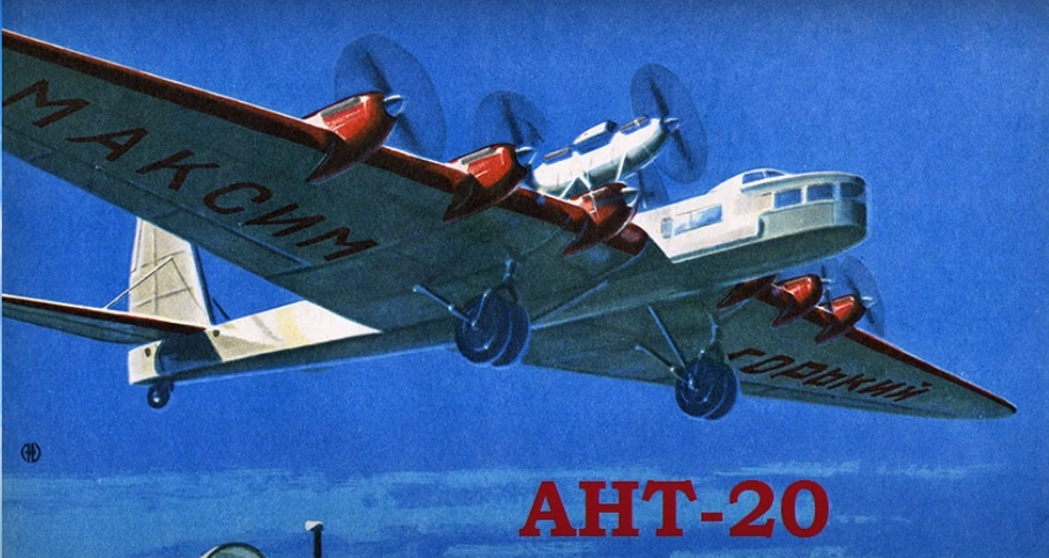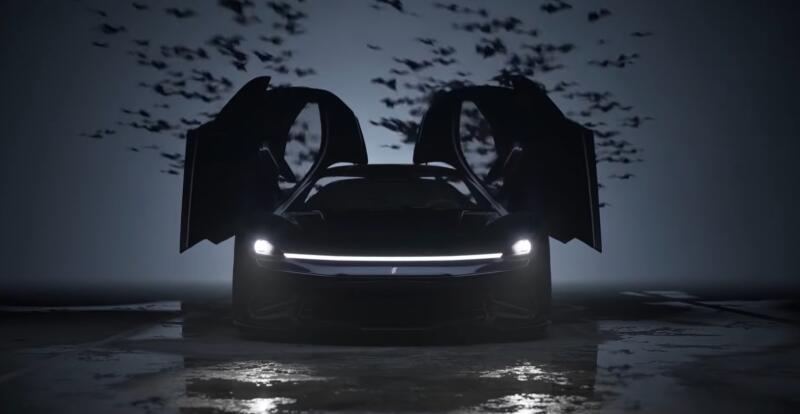"Maksim Gorky"
Where does this name come from? In the early 30s, the literary and social movement in the USSR was on a special rise. And, of course, such a master of the pen as Gorky is always in the spotlight. And then, at the end of 1932, the fortieth anniversary of the writer's literary activity was planned. And what can a country that has just recovered from civil war and devastation give him? The proposals were different, and everything was in the spirit of the time - boots, a collection of works by the author himself, a pipe that Gorky rarely parted with, etc. However, the well-known poet Mikhail Koltsov, who headed the Ogonyok magazine, surpassed everyone at that time. He proposed to build a "giant propagandist aircraft" with public money, which would personify the "new society".
The thought could not be called a fantasy from the ceiling. On the "balance sheet" of Russia there was already the famous "heavyweight" aircraft "Ilya Muromets" and the less well-known "Grand", "Russian Knight". By that time, long-distance flights had been made to many European capitals on the Wings of the Soviets (ANT-9) liner, the ANT-4, called the Country of Soviets, flew to New York.
 ANT-4 under construction - such a contraption flew over the Atlantic Ocean! Photo: YouTube.com
ANT-4 under construction - such a contraption flew over the Atlantic Ocean! Photo: YouTube.comIn 1931, the legendary man Mikhail Gromov lifted into the sky a 5-engine passenger plane Pravda (ANT-14), which flew more than 1000 hours without accidents. The military was also no stranger to the "spirit of gigantism": the TB-3 and TB-4, which were heavy bombers, were put into operation.
How the ANT-20 was built
In the country, the idea of a plane was received with enthusiasm and money was raised quickly. I wonder if this is possible now? Throw in the whole world on some new MS-22? And then it was okay. In 1933, an agreement was signed with the design bureau, headed by Tupolev, to develop the vessel. And here the poet Koltsov (editor of the Ogonyok magazine, under whose auspices the funds were raised) handed over a check for 500 thousand rubles to the aircraft designer. (a skilled worker received 250 rubles a month, bread cost 85 kopecks, meat 6-7 rubles). According to the scheme, the new aircraft was a constructive continuation of the TB-4 bomber. However, the terms of reference departed from the military "rail".
 The predecessor of the ANT-20 is the TB-4 bomber. Photo: YouTube.com
The predecessor of the ANT-20 is the TB-4 bomber. Photo: YouTube.comIt was necessary to build a liner that can be used to transport both passengers and cargo. And at the same time, no one canceled the “dual purpose”: the ANT-20 could be used as a “flying” headquarters and a bomber. Accordingly, it is necessary to place the necessary equipment inside: a film and photo laboratory, an automatic telephone exchange, a printing house, radio stations (more than one!) And even a loud-speaking installation under the name “Voice from Heaven,” which is curious for an atheistic society.
 Internal structure of ANT-20. Photo: YouTube.com
Internal structure of ANT-20. Photo: YouTube.comThe “stuffing” was serious, and at the same time the aircraft was “ordered” to take off from a dirt strip up to 400 m long. To achieve such characteristics, it was necessary to increase the wing area and its length. Six M-34FRN engines with a capacity of 750 "horses" were not enough, we had to additionally place a couple more above the fuselage. The plane turned out to be quite viable: if two engines failed, the flight continued.
In the West, they were skeptical about the idea: the British magazine Airplan wrote about the "Russian imagination" and that if such a giant takes off, it will not sit down - it will fall apart.
However, on 10.04.1934/20/10 the aircraft was ready. Its individual parts were transported to the Central Airfield, where they were safely assembled into a single whole. Already in June, Mikhail Gromov took off for the first time on a giant into the sky. The test pilot did not get tired of praising the liner, emphasizing the "convenient and simple" control and reliability of the design. Such a review made it possible for the ANT-15 to take part in the parade honoring Chelyuskin polar explorers. At the same time, the first world records for carrying capacity were set - first 5, then XNUMX tons per XNUMX km of height.
Design features
The fuselage was made of duralumin with corrugated skin. The plane was so huge that the passengers were accommodated even in the wings of two meters in height, and the pilots had access to the engines from the inside in order to repair them if necessary. Technical parameters of ANT-20:
✅ wingspan - 63 m (for the modern turboprop An-22 - 57,3 m)
✅ empty takeoff weight (maximum) - 31,2 t (42 t)
✅ the total power of the power plant of 8 motors is 7200 hp. With.
✅ range - 1000 km
✅ speed - 275 km / h
✅ ceiling - 7,5 km
All control mechanisms of the stabilizer, fender liner, had electric servo drives, which reduced the force on the steering wheel. The ANT-20 had its own AC power plant to power the equipment, which was an innovation for aircraft.
Equipment and comfort
Seats for passengers were “staffed” with soft armchairs, the floors were covered with carpets, there were tables with lamps. Sleeping "cabins" are provided, the liner had washbasins and toilets, passengers had a buffet where hot dishes were served.
 You can also eat in comfort. Photo: YouTube.com
You can also eat in comfort. Photo: YouTube.comAnd on board there was a warehouse with products, a library. A cinema is provided for watching films, communication was carried out through an automatic telephone exchange for sixteen subscribers.
 One of the offices: just like in the office! Photo: YouTube.com
One of the offices: just like in the office! Photo: YouTube.comA loudspeaker installation was also used, broadcasting directly from the sky. In total, 72 passengers were accommodated, the total “living area” was about 100 square meters. m. In 1935, the French writer Antoine de Saint-Exepuri flew on this liner.
Tragedy
The plane made regular flights over the capital, carried and honored the leaders of production. 18.05.1935/38/9 decided to "ride" the participants in the implementation of this grandiose project: workers, their children, designers, ordinary engineers, a total of 20 people, plus 5 crew members. There was also a cameraman on board. Ant-XNUMX was accompanied by I-XNUMX fighters, one of which was piloted by N. P. Blagin. This was necessary in order to clearly demonstrate the huge size of "Maxim Gorky".
 The plane seemed huge against the background of the fighters accompanying it. Photo: YouTube.com
The plane seemed huge against the background of the fighters accompanying it. Photo: YouTube.comAccording to a pilot flying on another fighter, Blagin suddenly began to spin aerobatics around the giant. Trying to fly around the wing of the ANT-20, the pilot could not hold the fighter, which crashed onto the wing of the liner. The giant did not survive such a blow, went into a dive, rolled up the chassis and fell to the pines, falling apart.
 A moment of tragedy. Photo: YouTube.com
A moment of tragedy. Photo: YouTube.comWhy the pilot began to turn dangerous pirouettes near the ANT-20 is still unclear. Either the cameraman asked (before the flight he had a long detailed conversation), or it was his personal initiative or someone's request. The assumption of a planned sabotage did not fit: the pilot was buried with honors, the family received an increased pension.
End
The aircraft was built in a single copy. However, this does not mean that the idea of advanced technologies has been buried. The public took the tragedy in its own way: funds were raised for the construction of 16 more such aircraft. At the end of the summer of 1939, the PS-124 (ANT-20 bis) was tested, which was a multi-seat six-engine passenger liner. It was actively used on airlines in the pre-war years and later. The aircraft differed from the Maxim Gorky in a smaller number of engines, which, however, had more power. Its characteristics:
✅ wingspan - 63 m
✅ 6 AM-35 engines - 7200 hp With.
✅ empty weight (maximum takeoff) - 31,2 tons (44 tons)
✅ average speed - 235 km / h
✅ range - up to 1300 km
✅ ceiling - 5,5 km
✅ number of passengers - 64
The plane was built in a single copy - the war began and the collected money was put to better use. The fate of the PS-124 is also tragic, like its predecessor. The liner made passenger flights in the south of the country. In December 42, during a normal flight, the commander of the ship "gave the steer" to one of the passengers, who deliberately or accidentally turned on the stabilizer. The plane went down and broke into a dive. The co-pilot did not have time to react.
 PS-124 had only 6 engines. Photo: YouTube.com
PS-124 had only 6 engines. Photo: YouTube.comOn this line of multi-engine low-speed "heavyweights" was interrupted. The country gradually entered another, jet era of aircraft construction. But this does not mean that everyone has forgotten about the screw giants - they have been built for more than half a century, which we will talk about in the next article.










